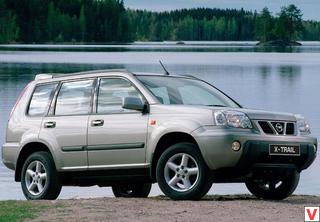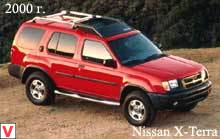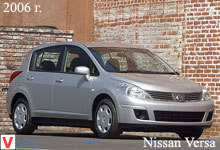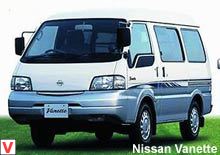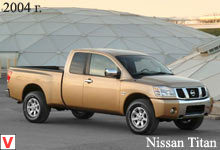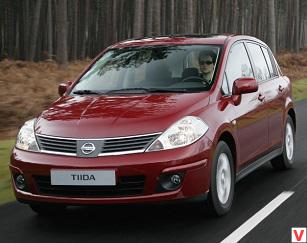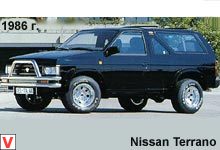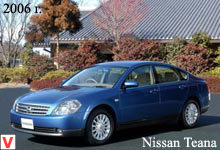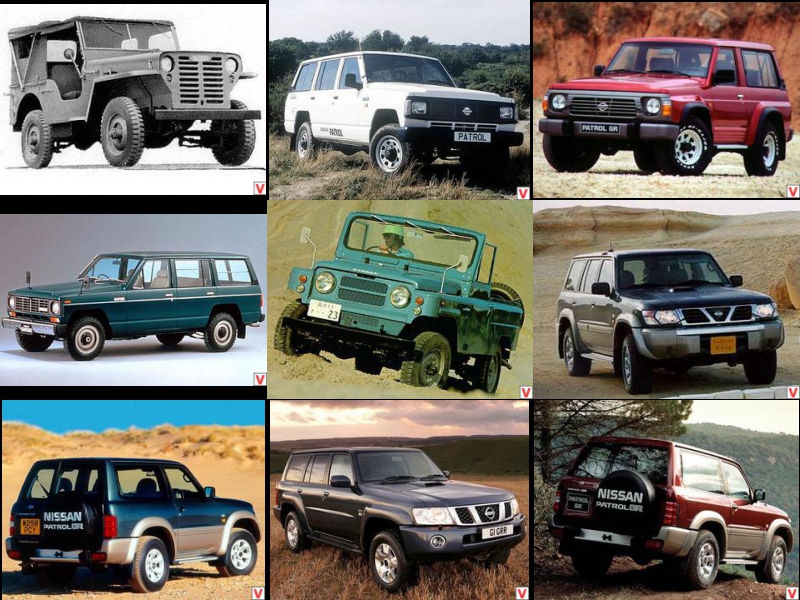
NISSAN Patrol - models of off-road vehicles with rear or four-wheel drive. All over the world, Patrol cars are deservedly popular as professional SUVs. The history of the model lasts for more than 50 years and has more than one generation of these cars. The name Patrol first appeared in 1951 and then belonged to the very first Japanese SUV, very simple in design, created in the image of the legendary JP and Land Rovers and serving for the needs of the army and police. It was a primitive but durable open-body machine.
The modernized car externally differed from its American counterpart by a full-fledged windshield, a slightly different “front end” solution and a cabin isolated from the outside world. This model has acquired deaf sides and doors with plexiglass windows. Moreover, not a tent was used as a material, but a more tactile leatherette. The basis of the car was a rigid spar frame with dependent front and rear suspension. All-wheel drive transmission without a center differential with a connected front axle was completed with a 3-speed manual gearbox and a chain “razdatkoy” with two rows of gear ratios.
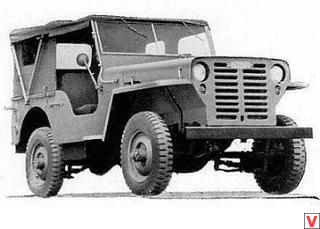
Under the hood of the car installed four-liter six-cylinder in-line gasoline engine with a capacity of 85 liters. from. In 1960, the Nissan debuted a more comfortable 60th series in a row. The body of the Patrol 60 series has become a two-door hard (such as hardtop), while remaining archaic, as in our UAZ, the front panel with nothing covered with metal cladding, flat sidewalls of the body and front wings separated from the bonnet. For the first time, engineers of the company prepared two modifications at once. The first, short version, wore the designation G6 and had a wheelbase of 1200 mm. while the body length of 3779 mm could accommodate four people.
The base of the second model was extended to 2500 mm and assigned the VG6 index. This version with a body length of 4240 mm, thanks to folding benches located along the sides, could accommodate up to eight people. Techniques of the 60th series, by and large, did not affect the changes. Significant improvements have touched only the power unit: instead of the 6-cylinder gasoline engine, the same six row of diesel engines was placed in the Patrol engine compartment.
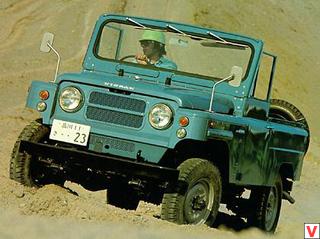
Moreover, the working volume was increased to 3956 cu. cm. Initially, its capacity was 125 liters. from. But in 1965 it increased to 135 liters. from. With such a power supply, a heavy SUV could reach a speed of 125 km / h.
This model was made in 60-70gg, and with a slight increase in the load-carrying capacity of the body, the capacity of the cabin and trunk since 1968. In total, the Patrol 60 Series went off the company stocks for as long as 20 years. At the end of 1979, NISSAN released a completely new model of the all-terrain all-wheel-drive car Patrol, which became the most popular of all existing generations of this model. It was a series of 160 (Patrol R, MQ). In 1980, this car was introduced in Europe, in France, at the Paris Motor Show.
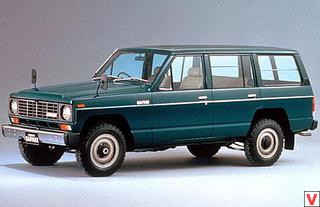
The body design and power units were thoroughly modernized: instead of the outdated square compartment, the same form, but quite modern (for the early 80s), body with square optics, having three- and five-door versions, appeared. In addition to the only four-liter four-liter diesel "six" added to the European market a similar gasoline unit. In Japan, Patrol was offered in versions with 2.8, 3.0, as well as with 4.5-liter petrol. In 1981, in Europe, cars with a shortened wheelbase, equipped with 3.3 liter six-cylinder diesel engines with naturally aspirated 95 hp, went on sale. In addition, to replace the old "mechanics" prepared a 4-speed fully synchronized gearbox.
The market was also offered Patrol, released under the brand name Ebro, released by Motor Iberica in Spain. It was installed diesel Perkins volume of 2.7 liters, and later - 2.8 liters. Subsequently, the Spanish Patrol was equipped with various engines, including a four-cylinder diesel engine of 2.8 liters, as well as NISSAN, as well as others. Later, the sale of cars produced in Spain, as in Japan, under the brand name NISSAN, was discontinued. However, in Iran, where the production of licensed Patrol 160 began in 1985, they are still being made.
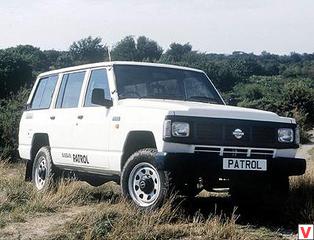
Soon after the release of the model Patrol 160, the company prepared a replacement for it in the face of the new 260th series (Patrol 260). Versions of the 1983 model year were only slightly retouched, replacing square headlights with round ones and slightly ennobled the body. The exterior of both cars had a lot in common, although a more powerful bridge was placed on the 260 series, which was why the load capacity was 300 kg more.
The new Patrol, like its predecessor, was offered in the short and long base versions. Moreover, there were options with a low and high roof, in which the top could be either iron or removable plastic. In addition to a 2.8 liter petrol four-cylinder engine and a 3.3 liter six-cylinder diesel engine (with and without turbocharging), a completely new six-cylinder 2.8 liter turbo-charged diesel engine has appeared, which has a number of technical innovations. With a rotational speed of 4400 rpm, the engine developed 115 hp in the turbocharged version and 93 hp without it. Production of some modifications of the 260 series also continues the Spanish Nissan to the present, with minor changes.

With the advent of the 260 series in the Nissan production range, the company began to take an active part in various rally raids. In 1984, Patrol won the legendary Paris-Dakar rally in the unrequited diesel class, and a year later he repeated his success. In general, the beginning of numerous NISSAN sports achievements is connected with this car - for many years the Patrols remained almost the sole leaders among SUVs, winning prizes in numerous rallies.
Later, Patrol Y60 picked up the victorious baton, which also had the second, more common name GR - after the capital letters of two words Grand and Raid ("big raid") - the car appeared in 1988. In Japan, it was called none other than Safari - in memory of the successes in the field of rally-raids. Patrol GR (Y60) was a more equipped and more comfortable car, it was distinguished by a number of features. This is a wider track, and, as a result, arch extensions, clutch drive amplifier, differential lock, rear disc brakes.

The wheelbase traditionally varied in length, and the roof in height. Instead, archaic springs bridges planted on the springs, although there was also a spring version. The suspension on coil springs is more comfortable than on leaf springs installed on all previous models. The five-door Patrol offers a spacious lounge, however, the short-base three-door version is more suitable for driving on rough terrain.
They installed an inline 2.8 liter six-cylinder diesel with 115 hp turbocharging. or a 4.2 liter petrol engine with a power of 175 hp, combined with an automatic transmission. The Patrol GR model, first shown in the autumn of 1997 at the Frankfurt Motor Show, is the fifth generation of the flagship SUV of the popular series, which received the Y61 index. The car body is fully updated, Patrol GR has received rounded sleek shapes in the spirit of the trends of the times, increased dimensions and even richer equipment. The design of the new model conveys the character of the car - a powerful, solid SUV with a high level of comfort.
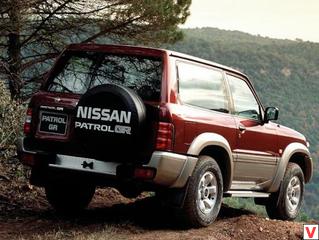
Appearance corresponds to the image of a durable and harsh SUV. Patrol GR can be recognized by chrome-plated jumpers on the false radiator grille in the shape of a letter V. With an overall length of 5010 mm, a width of 1930 mm and a height of 1855 mm (in the 5-door version), capable of overcoming a water obstacle 700 mm deep and having an excellent entry and exit angle The Patrol GR is one of the most impressive and practical off-road vehicles. In addition to the extended 5-door version, there is also a 3-door version of the model with a short base (4395 x 1840 x 1840). In a fully reworked bodywork, zones deformable during collisions increased and intensified.
As a result, shock resistance improved, especially in a frontal collision. Changes to the body and chassis also include a wider front and rear track for increased stability, a 100 mm increase in water obstacle clearance (700 mm), a longer front suspension stroke and an increased exit angle. The maximum angle of allowable roll increased to 48 degrees (from 44 degrees on the previous model). In addition, the Patrol GR V generation, like its predecessors, offers a choice of rear-wheel drive mode on normal roads or all-wheel drive in difficult road conditions.
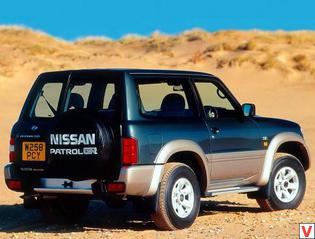
Switching these modes can be done while driving. The transfer box allows the driver to downshift in difficult to reach places, and the increased friction rear differential is standard equipment or can be replaced with a forced locking rear differential as an option. Technical improvements provide high stability Patrol GR on the road and off-road conditions. Patrol GR was the first car in Europe with switchable stabilizer bar. When driving on the road, the included stabilizer ensures the stability and comfort of passengers, preventing body roll. Compared with the old, the new body offers several significant, though not obvious at first glance, advantages.
Thanks to a new technology for manufacturing lenses, the light beam from the headlights of the new Patrol GR has a propagation angle of 60 degrees (instead of 36 degrees from its predecessor). the rigidity of the racks increased and, accordingly, the maximum permissible load on the roof - now 200 kg of cargo can be loaded on the upper trunk. A large glazing area increased visibility, the narrowed tunnel of the floor made it possible to reduce the shift towards the pedal assembly.
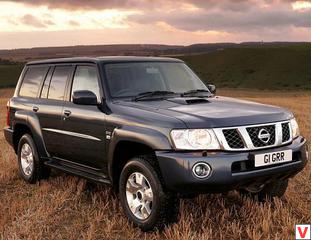
In general, the body from the inside has become more spacious - at the level of the legs and shoulders of the passengers, and in the trunk. The driver's high seat allows him to see the possible danger from afar, while the power steering wheel ensures the car’s stability at high speed and precise steering. As for the interior, the Patrol V took over directly from its predecessor only a very good four-spoke steering wheel. But it is located closer to the driver, which, in addition to adjusting the steering column tilt, comfortable seats with decent lateral support and well-composed pedal assembly with a platform for rest of the left leg makes the driver's seat natural and almost “passenger”.
Cute door panels, a central armrest, a beautiful front panel with a laconic and readable instrument cluster recessed into the interior - everything is like in a good passenger car. On request, the salon can be trimmed with genuine leather. However, for particularly unpretentious car owners there is a cheaper version (usually with a diesel engine), although in terms of equipment, it is also far from its descendants. Raised rear seats improve visibility and a sense of space for rear passengers.
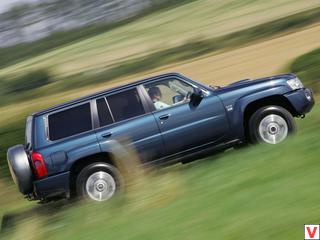
If in the short car the rear passengers especially do not walk around, then in the long “car” a wide sofa folding separately in half is prepared for them, and in the trunk there are two more folding seats that make the long Patrol seven-seater. The size of the luggage compartment has increased, while the new Patrol GR has retained a double, asymmetrical tailgate from its predecessors for easy access to the luggage compartment and ease of loading luggage.
A choice of three levels of configuration - Comfort, Suite and Elegance, as well as the new Patrol GR offers a large selection of standard and additional equipment, it is possible to install automatic climate control, equipment, mechanical or electric winch. Particular attention was paid to acoustic comfort. The noise level of the air conditioners is reduced from 69 to 64.5 dB, including a 90% reduction in the noise level of the transmission.
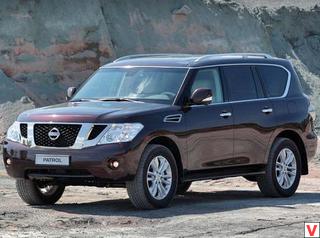
On cars, a 6-cylinder in-line diesel engine with a 2.8 D turbocharger is installed with electronic control of a high-pressure fuel pump (TNVD), with new pistons, a cylinder head, intake and exhaust systems, as well as other turbo-compressor, intercooler and increased volume radiator. Turbo diesel power is now 129 liters. from.
against the previous 113 l. from. and develops at 4000 rpm, and the torque curve extends smoothly from 1500 rpm to almost maximum speed, reaching a peak of 235 Nm at a relatively low 2000 rpm. (Japan also has a 4.2 liter turbo diesel with a power of 160 hp and a 4.5 liter gasoline engine with a power of 200 hp.). The maximum speed of 155 km / h. In the summer of 1999, the upgraded Nissan Patrol GR SUV was introduced at the Geneva Motor Show.

New 3-liter diesel engine with turbocharging, intermediate cooling and electronic fuel injection, developing 158 hp (116 kV) at 3,600 rpm and a torque of 354 Nm at 2,000 rpm (5-door version), uses M-Fire’s unique combustion technology to achieve a significant increase in power, torque, efficiency and purity, as well as significantly reduce fuel consumption and noise level. Maximum speed increased to 165 km / h. A five-speed manual or four-speed automatic transmission is installed on the car. As for passive safety, the creators of the car claim that the new body with reinforced crumpling zones was specially optimized for frontal crash tests with overlapping.
A 45-liter inflatable airbag in the steering wheel and pyrotechnic pretensioners of front seat belts with electronically controlled fuses are offered to customers as standard equipment, and a 110-liter airbag for the front passenger is at extra charge. By the way, the sensor that gives the command for the pillows and pretensioners is now located not in the steering wheel, but in the floor. This should reduce the propensity of the system to spontaneous operation with strong but non-hazardous impacts, which are quite possible with off-road driving.
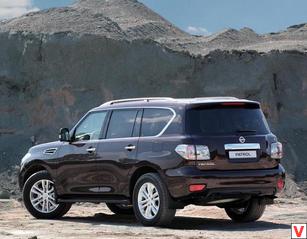
The security system also includes a four-channel ABS, which has five sensors that automatically determine the nature of the movement, and able to work with a locked rear differential; fully adjustable front seat head restraints and Nissan A / ELR seat belts in the rear seats, as well as the latest immobilizer NATS. Nissan constantly participates in off-road competitions in Europe, Asia, Africa and the Middle East. Multiple successful performances in all popular international marathons speak about the strength and reliability of the design of the Nissan Patrol GR. With the latest generation of the jeep, the company once again dared to perform in rally-raids.
Unlike in previous years, when emphasis was placed on diesel versions, this time a car with a 4.5-liter petrol unit was prepared. In 1998, held trial performances. And in the next season, Patrol showed good results. Success was waiting for the drivers who spoke at Patrol the following year 2000, when the car at the Paris-Dakar rally won the T1 class. In 2001, the legendary SUV Nissan Patrol GR celebrated its 50th anniversary. Reliability, time-tested off-road qualities, safety and comfort of the Nissan Patrol, have been repeatedly confirmed in various situations. And now, Nissan is the next update - the petrol version of the legendary SUV.

From generation to generation, the Nissan Patrol has become more comfortable and luxurious. If the first, fifty years ago, Nissan Patrol was an analogue of an ascetic army all-terrain vehicle, with an appropriate level of comfort, then each subsequent generation exceeded its predecessor by an order of magnitude in all respects. The appearance of the new Patrol GR 4.8 is slightly different from previous versions of this SUV. A new, more aggressive front bumper with integrated fog lamps has appeared. Chrome trim grille is now a new form.
The exterior door handles and rear-view mirrors are also covered with shiny metal. There were wide steps. You don’t have to guess the purpose of the Nissan Patrol for long: with all its appearance the car demonstrates that its elements are impassable jungle, quicksand, viscous swamps and broken dirt roads. Technical improvements provide high stability Patrol GR on the road and off-road conditions.

Patrol GR was the first car in Europe with switchable stabilizer bar. When driving on the road, the included stabilizer is responsible for the stability and comfort of passengers, despite possible body rolls, in bends Patrol behaves very stably and reliably. When driving off-road, the stabilizer off allows for maximum movement of the wheels relative to the body, improving traction. At the heart of the car is still a powerful spar frame. Although the suspensions remained dependent, now the spring is not used as an elastic element, but a more sensitive and soft spring. The new Patrol GR is equipped with modern equipment and features a rational organization of the internal space.
In the five-door Nissan Patrol GR on seven rows of seats seven people can freely accommodate. The third row can be removed or, like the second row, folded in a ratio of 50:50, providing additional space for carrying baggage. However, with a substantial volume of this trunk - 2287 liters - quite numerous artifacts, pockets and even taynichki, which are scattered around the cabin in abundance, can well argue.
Salon is only leather, perforated, as the steering wheel. Even on the steering wheel with inserts "under the tree" - the keys for controlling the cruise control and radio. Convenient and intuitive location of control devices. The dashboard with the ignition off - black, almost opaque glass.
It is enough to turn the ignition key - and the instrument scales begin to burn with “white-moonlight” light, and the arrows turn bright red. Under the radio itself, right on the center console - a six-disc CD changer. In the air conditioner - a filter that delays poplar fluff and exhaust "Icarus." There is even a separate control air flow, aimed at the rear sofa, - at the request of the passengers it can be strengthened or stopped altogether. The cabin is equipped with electric seat adjustment and heating. - at the request of passengers, it can be strengthened or stopped altogether. The cabin is equipped with electric seat adjustment and heating.
- at the request of passengers, it can be strengthened or stopped altogether. The cabin is equipped with electric seat adjustment and heating. Nissan is equipping the European version of the Patrol GR with the latest 4.8-liter gasoline engine.
capacity of 245 "horses" in combination with a torque of 400 Nm, which heads the list of improvements designed to prepare the legendary Patrol GR to new market conditions and the requirements of the modern buyer. As before, Patrol GR is equipped with a three-liter turbo diesel engine with direct fuel injection. The powerful version differs from others also in the fact that it is equipped with a five-step “automatic” with manual shift function - also, by the way, a very expensive and rare option so far. And this "automatic" with might and main is trying to make the engine at any time in the zone of optimal revolutions.
If the “automaton” does not work, then you can do it yourself - by swinging the lever to the left, you switch to manual mode, where gears change by swinging the lever back and forth. Even on a broken primer "Patrol" easily accelerates to 100 km / h, freely jumping over all obstacles and not really "thinking it over" in front of the pits. The premiere of the 2010 Nissan Patrol was held in the Abu Dhabi capital of OAU in February 2010.
First of all, the company Nissan radically changed the positioning of the Patrol from the expedition to a luxury SUV. The car has radically changed outwardly, the level of comfort and the quality of trim have increased significantly. Patrol 2010 is not at all like its predecessor: its forms are smoother and more dynamic, but the soft forms of the body do not go to the detriment of masculinity and impressiveness. Compared with its predecessor, Patrol has grown significantly, instead of continuous bridges, it has received an independent spring suspension, inheriting from the previous Patrol only a frame structure of the body.
The frame itself, however, has changed, and its individual elements (in particular, the power frame in the rear door opening) are now closed on the supporting structure of the body. This is in order to create zones of plastic deformation (important from the point of view of passive safety) and reduce the level of vibrations. Patrol 2010 is equipped with a 5.6-liter 400-horsepower eight-cylinder V-shaped gasoline engine, which allows you to accelerate the car to a hundred in 6.6 seconds and has a torque of 560 Nm at 4000 rpm. Fuel consumption - 14.5 liters in the combined cycle, in the city - 20.6 liters.
In tandem with this power unit operates a 7-band automatic transmission with manual shift mode. Previously, Patrol had a lowering number of transmissions and inter-wheel differential lock. And all this had to switch the driver in their own discretion. Now the driver is thinking electronics: the All Mode 4 × 4 transmission has four automatic modes: “sand”, “asphalt”, “snow” or “stones”. Each mode has its own settings for the operation of the ABS and stabilization system. The Hydraulic Body Motion Control (HBMC) system, which keeps the body from lateral vibrations, allows you to actively maneuver at high speed.
It works with rolls, opening and closing the valves-locks of anti-roll bars, reducing the buildup. In addition, part of the new ALL MODE 4x4 system are auxiliary subsystems of starting uphill (HSA) and controlled descent (HDC). If the driver stops on the rise and removes his foot from the brake pedal, the HSA system holds the car, not letting it roll back.
The HDC system uses brakes, maintaining a constant speed of the vehicle on the descent: 7 km / h in 4H mode and 4 km / h in 4L mode. In addition, this system allows you to drive backwards on a descent at a constant speed: 4 km / h in 4H mode and 3 km / h in 4L mode. The length of the car has grown by 95 mm (up to 5140 mm), the wheelbase - by 105 mm (up to 3075 mm). Due to the increase in the size of the cabin it became more spacious and comfortable, for the passengers of the second row the legroom increased by 10 cm, it became more spacious for the passengers of the third row. The interior has changed beyond recognition. Natural materials are widely used in the interior decoration.
The seats are covered with soft leather, and the controls are framed with aluminum and wood inserts. The cheeks of the center console from the driver and front passenger side are made soft and when the body rolls, the knee no longer beats against plastic. The lid of the box-cooler installed between the front seats leans forward and backward, which allows the passengers to open both the first and second rows. In this compartment easily fit six bottles with a capacity of 600 ml.
The third-row folding seats along with the backs are now stored under the boot floor (previously, the “stools” were fixed with straps along the sides, narrowing the luggage space), and in the unfolded position they leave behind about 40 cm of free space for the cargo. The interior has excellent sound insulation, even the front windows of the car are laminated with a special sound-absorbing layer.
The basic package includes: an improved system for monitoring air pressure in tires; infotainment DVD system; six airbags; fully updated climate control system, including the “air curtain” system relevant for hot climates: cooled air from the ceiling vents located above the side windows is fed along the glass, preventing the cabin from heating. Also included in the basic equipment: a circular review system for convenient maneuvering in tight spaces, a premium BOSE audio system with 13 speakers, a hard disk navigation system and an 8-inch WVGA display. In the configuration of the Pack is added to this electric sunroof, roof rails, displays in the front head restraints.
The maximum grade of the Pack + is upgraded with active safety systems: tracking cruise control, a system for monitoring traffic lane, monitoring blind spots. In 2013, the seventh generation of the Nissan Patrol (Y62) was released. The car received a new front bumper, modified front and rear optics. The false radiator grille is divided into two zones.
Standard top is much larger than the bottom. In addition, the developers have divided the upper zone with additional longitudinal lines under chrome, which gives some solidity to the car. At the very center of this composition is the company logo. On the side, the crossover body is characterized by chopped lines. The sides, the edges of the doors, the wheel arches have a blown shape. Chrome moldings appeared at the bottom of the door, and the design of the rims was changed. Depending on the level of the version, the SUV is equipped with tires 275/60 R18 or 275/60 R20 on alloy wheels 18 and 20 radius.
The lion's share of the stern is the tailgate, which quite organically fits into the overall look of the car. The bumper, as well as in front, has the impressive sizes. Lighting supplemented by a number of LEDs that go along the upper edge of the window.
Nissan Patrol 2014 retained the brutality of its predecessor, impressive dimensions and acquired great aggressiveness in design. The dimensions of an SUV are: length - 5160 mm, width - 1995 mm, height - 1938 mm. Wheelbase - 3075 mm. The ground clearance is 275 mm, so landing in the cabin sometimes causes difficulties.
Just to eliminate such difficulties, the designers have equipped the body with special steps. The value of Cd (coefficient of aerodynamic drag of the body) is equal to 0.4. The choice for buyers of the updated Patrol is seven colors of enamel for body painting: black does not require additional payment, and for white, silver, gray, light beige, gray-brown and purple it is necessary to pay extra.
The interior of the 2014 Nissan Patrol has changed little. All tumors are reduced only to the use of more expensive materials used for the seven-seater cabin. This is beige or black leather, and natural wood, and elastic, pleasant to the touch plastics, carpeting on the floor. The location of instruments and controls on the front panel is ergonomically aligned. The front row seats are comfortable and ergonomic. Lateral support with a rigid frame ensures the stability of the passenger and driver during the execution of shunting operations. Built-in electric drive and heating, longitudinal adjustments add a feeling of comfort.
Among other positive qualities can be identified effective noise insulation, which creates a quiet and relaxing atmosphere in the cabin. Patrol 2014, as befits a premium SUV, has a huge cabin and luggage compartment. In the back seat, the three passengers are very comfortable. Enough space for the head and legs. The volume of the luggage compartment when the car is fully loaded is 550 liters. If necessary, by carrying out several manipulations, the volume can be increased to 1,490 liters. To do this, add the third row. Well, if we add the second row and the front passenger seat, we get a space of 3170 liters.
If in Europe you can buy a car with both gasoline and diesel engines, in Russia the model is sold exclusively with a gasoline unit. Nissan Patrol 2014 is equipped with a V-shaped 8-cylinder gasoline engine with a displacement of 5.6 liters of cylinders with a capacity of 405 ps The peak value of the engine torque is 560 Nm, when it reaches 4000 rpm. This allows a full-size and solid SUV to accelerate from start to 100 km / h in just 6.6 seconds. The maximum speed of 210 km / h. The engine is completed with a 7-speed automatic transmission. Fuel consumption documentation varies depending on the mode of operation - 15-25 liters.
The seventh-generation Patrol has completely shifted to an All-Mode 4 × 4 all-wheel drive transmission. A powerful frame, a conceptual body and an electromagnetic clutch were also integrated. Such a bunch of devices allows the car to move in one of three modes of operation. Standardly they are designed for urban roads, light country trails and heavy off-road. As the flagship of the Nissan SUV lineup, Patrol offers a wide range of standard equipment and active safety shields. The car is equipped with a system of circular view (Around View Monitor) of the 3rd generation with increased front viewing angle up to 180˚.
The extended list of security systems includes a moving object recognition system (Moving Object Detection). In case of detection of moving objects during maneuvering, the system will give sound signals corresponding to the distance to the object, and duplicate them with visual information on the display. A collision avoidance system when reversing (Back-up collision intervention) warns the driver about objects that appear on the trajectory of reversing. To attract the attention of the driver, the system uses audible and visual signals and, if necessary, automatically applies the brakes.
